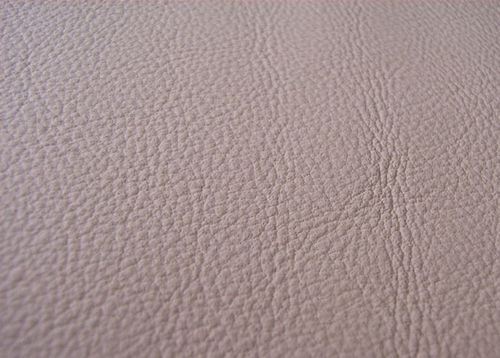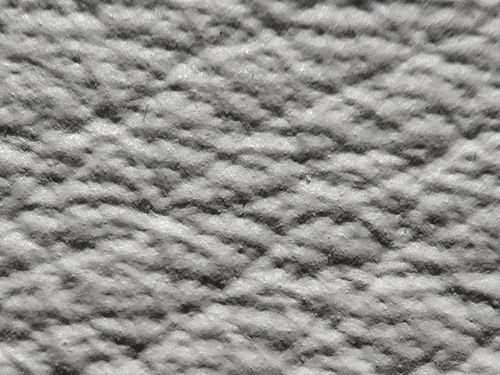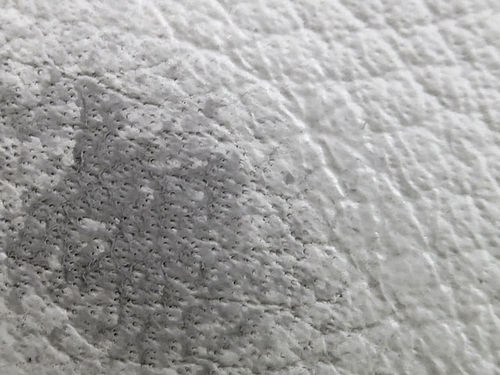Difference between revisions of "Barrel pigmentation - Drum pigmentation"
(Created page with "<p align=center> 300px </p> Gelegentlich taucht bei Lederbeschreibungen der Begriff '''Fasspigmentierung''' auf. Oft im Zusammenhang mit A...") |
|||
| (12 intermediate revisions by one user not shown) | |||
| Line 4: | Line 4: | ||
| + | ==What is a barrel or drum pigmentation?== | ||
| + | "Barrel pigmentation" and "Drum pigmentation" are terms that occasionally feature in leather descriptions. Normally, leather is soaked in barrels filled with [[leather colour#Dyed leather|dyes]] and then coated with a [[finish|pigment-containing colour]] on the surface for protection. | ||
| − | + | Barrel pigmentation is carried out in the [[tanning#re-tanning|retanning]] process. These very fine pigments are applied without binders so that the leather absorbs them to achieve equal colour coverage on the surface without closing the [[Leather hair pores - Hair follicles|pores]]. | |
| − | + | A disadvantage of drum pigmentation can be color shedding on the [[flesh side]], but this only matters if that side is processed open. Barrel pigmentation is often used on leathers with difficult shades. These include yellow, orange, black or white. The colors become more even and deeper due to the barrel pigmentation. | |
| − | + | If you put a classic [[finish|pigment based finish]] and binder in a drum with leather, the leather would be saturated with binder and feel like rubber or plastic. | |
| − | + | Since the barrel pigmentation does not close the pores, this process results in a completely [[aniline leather|open-pored smooth leather]]. There are descriptions of barrel pigmentation, according to which barrel pigmentation replaces the solvent-based, colored [[finish]]. However, since the barrel pigmentation does not create a protective layer on the [[grain side]], this cannot replace either solvent-based or aqueous binding agent-based finishes. | |
| − | + | The barrel-pigmented [[car leather#BMW|BMW leather]] is described as [[aniline leather|porous smooth leather]] without a [[finish|pigment layer]] on the [[grain side]]. The leather samples for the BMW Merino are all provided with a [[finish|pigmentation]]. They are not [[aniline leather]] but in fact [[Semi-aniline|semi-aniline leather]]. | |
| − | + | ||
| − | + | ||
| − | + | ||
| − | + | ||
<p align=center> | <p align=center> | ||
| − | [[bild: BMW- | + | [[bild: BMW-Leather-Merino.jpg|500px]] |
| − | + | ||
</p> | </p> | ||
<p align=center> | <p align=center> | ||
| − | ''[[ | + | [[bild: BMW-Autoleder-Merino.jpg|500px]] |
| + | </p> | ||
| + | <p align=center> | ||
| + | ''[[Finish|Pigmented]] [[Car leather#BMW|BMW Merino leather]].'' | ||
</p> | </p> | ||
| − | + | Previously known samples of leather with barrel pigmentation had [[finish|colour coatings]] on the surface when tested with a solvent. It was therefore not [[aniline leather]], but [[Semi-aniline|semi aniline leather]]. Whether these leathers are [[Haptic evaluation of leather surfaces|softer]] or more beautiful than semi-aniline leather without barrel pigmentation could not be determined. | |
<p align=center> | <p align=center> | ||
| − | [[bild:Lavalina- | + | [[bild:Lavalina-not-Anilin-02.jpg|500px]] |
| − | + | ||
</p> | </p> | ||
<p align=center> | <p align=center> | ||
| − | ''[[Lavalina | + | [[bild:Lavalina-not-Anilin-barrel-pigmentation-01.jpg|500px]] |
| + | </p> | ||
| + | <p align=center> | ||
| + | ''[[Lavalina leather]] that is barrel-pigmented also has a [[finish|top pigmentation]], which probably does not come from the barrel. The picture on the right shows how the [[finish]] was removed with solvents.''<br></p> | ||
<p> </p> | <p> </p> | ||
| − | + | As the information is not always clear, it is advisable to confirm the [[types of leather|type of leather]] used in the application of the barrel pigmentation. If a real [[aniline leather]] is desired, examine more closely to make sure that is what is being offered. | |
| − | + | ||
| − | + | ||
| − | + | ||
| Line 49: | Line 48: | ||
* [[Finish]] | * [[Finish]] | ||
* [[Leather colour]] | * [[Leather colour]] | ||
| + | * [[Lavalina leather]] | ||
Latest revision as of 14:25, 13 July 2023
What is a barrel or drum pigmentation?
"Barrel pigmentation" and "Drum pigmentation" are terms that occasionally feature in leather descriptions. Normally, leather is soaked in barrels filled with dyes and then coated with a pigment-containing colour on the surface for protection.
Barrel pigmentation is carried out in the retanning process. These very fine pigments are applied without binders so that the leather absorbs them to achieve equal colour coverage on the surface without closing the pores.
A disadvantage of drum pigmentation can be color shedding on the flesh side, but this only matters if that side is processed open. Barrel pigmentation is often used on leathers with difficult shades. These include yellow, orange, black or white. The colors become more even and deeper due to the barrel pigmentation.
If you put a classic pigment based finish and binder in a drum with leather, the leather would be saturated with binder and feel like rubber or plastic.
Since the barrel pigmentation does not close the pores, this process results in a completely open-pored smooth leather. There are descriptions of barrel pigmentation, according to which barrel pigmentation replaces the solvent-based, colored finish. However, since the barrel pigmentation does not create a protective layer on the grain side, this cannot replace either solvent-based or aqueous binding agent-based finishes.
The barrel-pigmented BMW leather is described as porous smooth leather without a pigment layer on the grain side. The leather samples for the BMW Merino are all provided with a pigmentation. They are not aniline leather but in fact semi-aniline leather.
Previously known samples of leather with barrel pigmentation had colour coatings on the surface when tested with a solvent. It was therefore not aniline leather, but semi aniline leather. Whether these leathers are softer or more beautiful than semi-aniline leather without barrel pigmentation could not be determined.
Lavalina leather that is barrel-pigmented also has a top pigmentation, which probably does not come from the barrel. The picture on the right shows how the finish was removed with solvents.
As the information is not always clear, it is advisable to confirm the type of leather used in the application of the barrel pigmentation. If a real aniline leather is desired, examine more closely to make sure that is what is being offered.
Additional information












 a kotori web solution
a kotori web solution